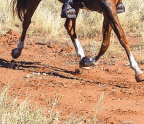QUARTER HORSES ADAPT TO A NEW CENTURY

The Gay Nineties in America were a decade of enormous optimism, when technology, mechanization and the rise of unions materially improved the lives of millions of white middle-class wage-earners. Progress came at a cost, however. Industry in this era depended for its energy needs largely upon coal; the foggy, smoggy London in which Sherlock Holmes sleuthed is an accurate description of the real Gay Nineties town in which Arthur Conan Doyle lived and worked.
As a new century dawned, “environmentalism” was unheard-of in the industrialized West and the concept of sustainability was on nobody’s mind---rather the thrust was toward maximum exploitation of natural resources. Yet the long-standing effects of air pollution created by burning coal were palpable to me even during the 1970s when I was a student worker at the American Museum of Natural History in New York City and at the National Museum of Natural History in Washington, D.C., There, in “the nation’s attic,” I worked with horse bones and fossils collected during the mid to late 19th century. Despite being carefully housed in great museums, the specimens were covered in a gritty, blackish-gray dust now rarely seen but common in all urban areas before 1945: coal ash mixed with tiny clinkers.
Taken as they were by the wonders of coal-fired electricity, which in the 1890s began to power everything from home lighting and telephones to steel manufacture, few people foresaw the impact that another fossil-fuel burner---the gasoline-powered engine---would soon have on every aspect of life. German inventor Carl Benz began selling his Benz Patent Motorwagen in 1888, the first commercially available automobile. Henry Ford built his first car in 1896 and founded the Ford Motor Company in 1903. Ford’s vision was to manufacture vehicles affordable to the average worker. Assembly-line production allowed mass manufacture in Ford factories, so that the price of a Model T went from $850 in 1908 to $360 in 1916, less than the price of a good horse. In 1924, Ford sold two million Model Ts for $290 each. Competitors soon followed suit, including Ransom E. Olds, the Studebaker brothers and Louis Chevrolet and his partners at General Motors.
The Model T design, modified as the Model B, became the first gasoline-powered machine to successfully navigate a muddy Midwestern field for springtime plowing and seeding. Fitted with cleated steel wheels and a tow bar, the noisy, unreliable, smoke-belching, hand-cranked, two-cycle Fordson, with its 16-hp engine, heralded the end of the horse-drawn plow, wagon and reaper. John Deere became Ford’s major competitor in motorized farm equipment first with the Waterloo Boy tractor and later the Spoker Model D. Industrial magnate J.P. Morgan acquired the McCormick Harvesting Machine Co. in 1902, combining it with several smaller firms to form International Harvester. During the 1920s its Farmall tractor competed directly with the Fordson, but the real losers were all the breeds of draft horses, draft mules and utility-grade wagon horses that had previously powered American agriculture. By the Dust Bowl years of the 1930s, the draft horse population in America had fallen almost to zero, so that the magnificent Belgians, Shires and Clydesdales now seen in pulling competitions, at state fairs and hitched to the Anheuser-Busch beer wagon descend almost entirely from importations made after the end of World War II.
Riding horses took a severe hit too, their numbers plummeting along with the general level of horsemanship knowledge. For the first time, books on “how to ride, handle and train” were written for people who had grown up riding bicycles and whose early experience of “gliding” on wheels made it difficult for them to get the necessary feel of the horse’s individually stepping feet.
You’re reading a preview, subscribe to read more.
Start your free 30 days



